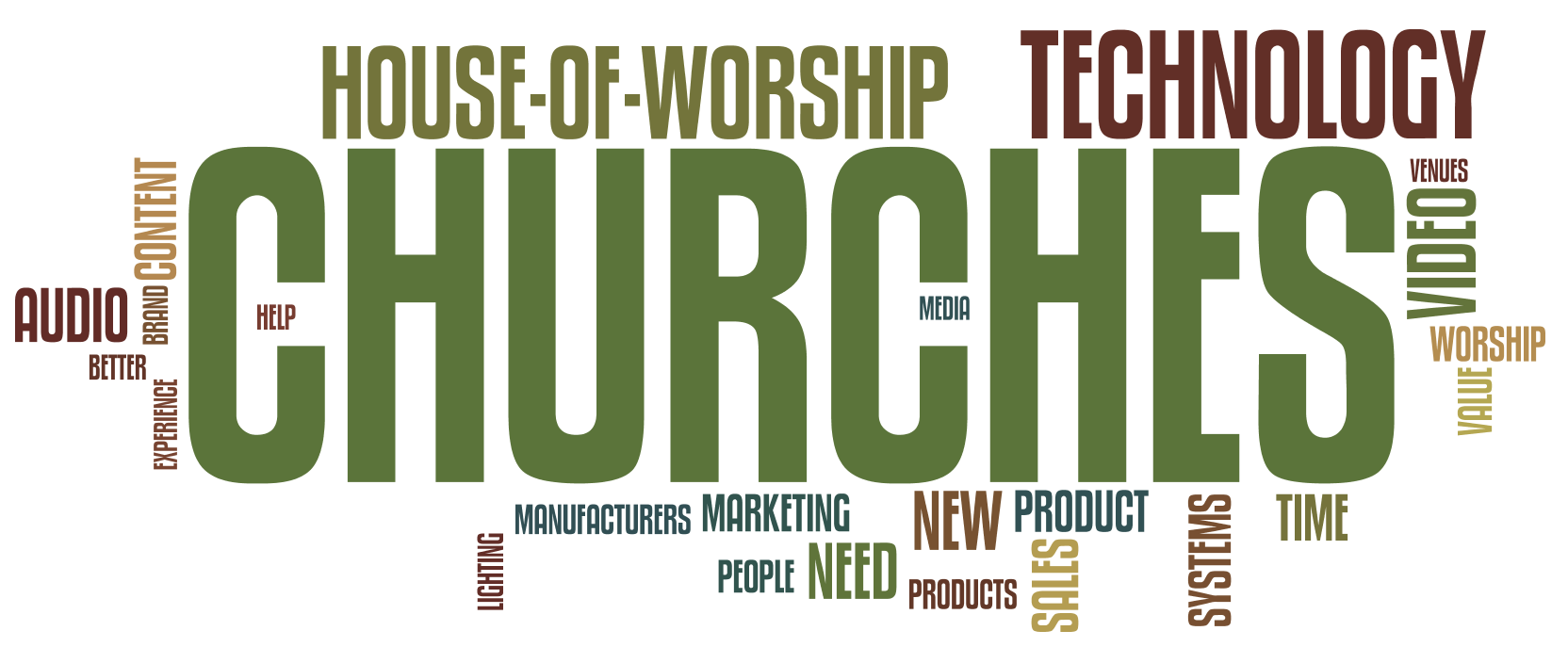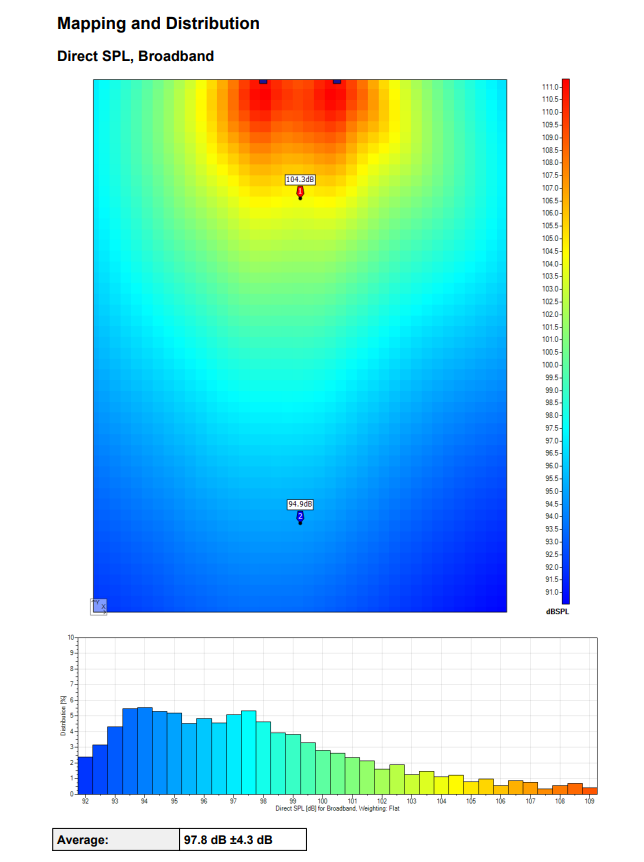Four Future Trends for the House of Worship Market

By aggregating trends from the past, we have a significant indicator of future trends and shifts in the House of Worship market. The word cloud graphic for this article lists the top 25 recurring words from all of the previous columns written here about the church market on rAVE, and they are an excellent look at what we’ve shared over the years that will likely be a focus of future articles.
For the manufacturers, systems integrators, and consultants reading these for insights on how to more effectively serve the 300,000+ churches in the U.S. alone, I’ve broken down these 25 words into four important categories to help identify the likely future trends for this oft-misunderstood market.
 The House of Worship Market: Churches, People, Venues, Manufacturers
The House of Worship Market: Churches, People, Venues, Manufacturers
The old child’s rhyme played by interspersing the fingers on two hands inward towards the palms reveals a truth of the House of Worship market. “Here’s the church. Here’s the steeple. Open it up and here’re the people.”
The church is less an institution and more an organic collection of individuals focused and centered around a shared affinity and belief system.
Connecting with these people to solve a set of common problems is the priority for manufacturers, consultants, and systems integrators. All too often, we lead with the solution before understanding the problem. There’s a great quote I read from Harvard Business Review that succinctly sums up how to address a prospect:
“Fall in love with the problem, not the solution.”
To be highly aware of the problem signals a proper focus on understanding client needs because it remains focused on contextualizing the issue of where each church currently is at in their journey as opposed to where they want to be. The authors, John Boudreau and Steven Rice, describe it this way: “You spend some time letting the challenge soak in, studying it from various angles, and understanding it more deeply. Rather than hastening to narrow the scope of your decision and the options under consideration, you remain receptive to additional, possibly better ones. “ They go on to say that the key is to maintain a long-term love affair with the problems that need solving and the business you are here to serve. The business of the church just so happens to have a weekly cadence, and the AVL technology needs to solve the problem and just flat-out work week in and week out.
In the House of Worship market, the problems are similar, but the solution is always a variable because of the people involved in the decision-making process. This approach isn’t all that different from other vertical markets because people are the common denominator.
Technology: Audio, Lighting, Video
Of course, audio, video and lighting are the three prominent technology categories here at rAVe, so it’s no surprise we’ve talked about them at great length as they pertain to the church market. However, before you gloss over this section, it is important to remember that more often than not, your technology is not the problem.
Having been a founding member of one of the first church technology conferences and a speaker and attendee at dozens of others, I’m not easily impressed by new technologies. My take on the gear presented to churches usually has this in common: the vendor promoting the technology suffers from understanding a great deal about the technology and precious little about the application of that technology within a church.
Much like the advice above to fall in love with the problem, it is endlessly helpful for vendors to talk about the problem more than the solution. Identifying with the potential influencers and decisions-makers through a shared understanding of a pain point helps solidify your credibility as you address the problem and begin to solve new ones before they occur. In this way, the path from problem to solution is a seamless journey for the prospect, allowing you to sell the solution and not the technology. After all, very few technologies are without competition, but a solution positioned in the context of a local church problem has no peer.
Sales & Marketing: Brand, Content, Media, Products
The third critical category to understand when selling into the House of Worship market has everything to do with your WAY and not your WHAT. Admittedly, the word count bias towards sales, marketing, brand and content are in alignment with my experience; as such, I talk a lot about that which I understand and want to share with you. Still, given the limited state of content marketing from AVL manufacturers and vendors, there’s room for lots of improvement in the way churches are addressed as it relates to these technologies.
When the value proposition for a product is both clearly defined and fits snugly within the felt needs of churches, the best advertising isn’t hype — it’s truth. Most brands have at least one product or family of products that have had rock-solid stability and earned respect within some portion of this vertical market. These user experiences are the building blocks for leveraging positive brand sentiment in expanding awareness and, hopefully, the use of your technologies.
The best way to win a complex sale to a group is not to lead with your product or solution, but to your product or solution. By helping the church accurately define the problem they are trying to solve with a complex technology solution, you will often need to show them what they think is probably incorrect. Additionally, the onus is on you to demonstrate that the solution isn’t merely about solving the problems they think they know about but bring them to a place where they’re addressing root-cause issues.
I’ve long advocated for vendors to create content aimed specifically at church buyers. I believe that content is the currency companies use to communicate stories that motivate purchases. Content marketing (and the use of content marketing automation) are strategic initiatives that should be employed post-haste. The buyer’s journey starts long before they fill out a form, send an email, or pick up the phone and targeted content puts the power of research and helpful stories in the hands of those willing to purchase.
Experiential Needs
The five words found in this category are all about the Result: The four words here are “Better, Help, Value, Systems, and Time.” They provide clues about what local churches are needing from both the technology and systems integration. It’s helpful to understand and has seen in person the extreme diversity in presentation, musical styles, and venues of today’s growing churches. As I talked about in my Trends article, this isn’t your grandma’s church of yesteryear.
From the café style churches that feel like an oversized Starbucks (complete with gourmet coffee) to the black box theaters with concert-level audio, video, and lighting (AVL) to the portable churches setting up in school gymnasiums and cafeterias, the experience is an essential part of these services. Technology in growing churches isn’t unseen, but a regular part of the visible and auditory experience.
Even in the most rock-n-roll styled church services where technology is a significant proportion of the presentation, the ultimate experience happens not when the SMPTE-controlled video track syncs with the lights and sound, but when the technology is so well implemented that it’s, well, invisible to the audience. In this sense, all churches have this in common: to have the technology serve to help create an atmosphere that doesn’t draw attention to the technology, but that the technology is simply a tool to achieve an end result.
But even for the largest churches with full-time paid professional techs, the experience is not complete without training and support. They need you. This truth has been and will continue to be an opportunity for the trifecta of the manufacturer, integrator, and church to work together harmoniously.
These four trend categories come from the historical data of four and half years worth or articles and decades of living research. To embrace them is to identify trends that will continue into the future buying phases of the underserved house of worship market.





